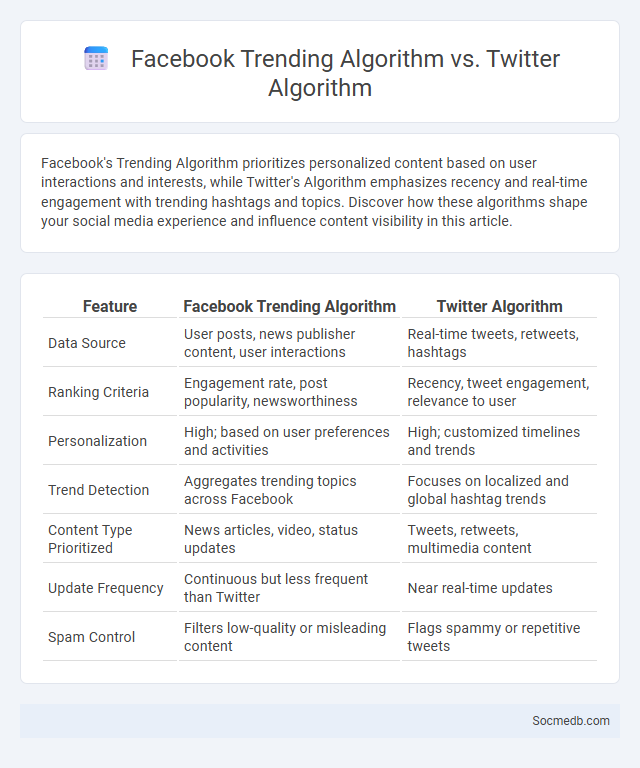
Photo illustration: Facebook Trending Algorithm vs Twitter Algorithm
Facebook's Trending Algorithm prioritizes personalized content based on user interactions and interests, while Twitter's Algorithm emphasizes recency and real-time engagement with trending hashtags and topics. Discover how these algorithms shape your social media experience and influence content visibility in this article.
Table of Comparison
| Feature | Facebook Trending Algorithm | Twitter Algorithm |
|---|---|---|
| Data Source | User posts, news publisher content, user interactions | Real-time tweets, retweets, hashtags |
| Ranking Criteria | Engagement rate, post popularity, newsworthiness | Recency, tweet engagement, relevance to user |
| Personalization | High; based on user preferences and activities | High; customized timelines and trends |
| Trend Detection | Aggregates trending topics across Facebook | Focuses on localized and global hashtag trends |
| Content Type Prioritized | News articles, video, status updates | Tweets, retweets, multimedia content |
| Update Frequency | Continuous but less frequent than Twitter | Near real-time updates |
| Spam Control | Filters low-quality or misleading content | Flags spammy or repetitive tweets |
Overview of Social Media Trending Algorithms
Social media trending algorithms analyze vast amounts of user data, including engagement, relevance, and timeliness, to deliver personalized content feeds that maximize interaction. These algorithms prioritize posts by evaluating metrics such as likes, shares, comments, and user behavior patterns across platforms like Instagram, Twitter, and TikTok. Understanding how these algorithms work can help you optimize your content strategy for better visibility and reach.
How Facebook’s Trending Algorithm Works
Facebook's trending algorithm prioritizes content based on engagement metrics such as shares, comments, and reactions, identifying topics gaining rapid attention to present timely and relevant information. It leverages natural language processing (NLP) to categorize stories by theme and source credibility, ensuring Your feed features validated, popular discussions. The system continuously updates by analyzing local and global trends, adapting to user behavior and preferences for personalized content delivery.
Understanding Twitter’s Trending Algorithm
Twitter's trending algorithm identifies popular topics by analyzing tweet volume, velocity, and user engagement within specific geographic locations. It leverages machine learning models to filter out spam and repetitive content while prioritizing diversity in the trending list. Understanding this algorithm helps marketers optimize content timing and hashtag strategies to increase visibility.
Key Differences Between Facebook and Twitter Trends
Facebook trends emphasize community engagement through detailed posts, photos, and videos shared within personal networks, promoting deeper interactions and longer content lifespan. Twitter trends highlight real-time news and conversations with brief, concise tweets and hashtags that rapidly spread information across a diverse global audience. The platform algorithms differ, with Facebook prioritizing personalized content based on user behavior, while Twitter emphasizes trending topics driven by volume and velocity of tweets.
Data Signals Used for Trend Detection
Social media platforms analyze vast amounts of data signals such as hashtags, user engagement metrics, share frequency, and sentiment analysis to identify emerging trends in real-time. Machine learning algorithms process these data points to detect patterns and predict viral content before it peaks. Understanding these signals can help you strategically tailor your content to capture and capitalize on trending topics effectively.
Algorithm Transparency and User Trust
Algorithm transparency plays a crucial role in building user trust on social media platforms by revealing how content is curated and prioritized. Clear communication about data usage and content ranking criteria empowers users to make informed decisions and reduces concerns about manipulation or bias. Enhanced transparency fosters accountability among social media companies, encouraging ethical practices that strengthen overall user confidence.
Manipulation and Fake Trends: A Comparative Analysis
Social media platforms often facilitate the spread of manipulation and fake trends, influencing public opinion through coordinated misinformation campaigns and algorithm-driven content promotion. You must critically evaluate sources and recognize patterns of artificially amplified content designed to exploit engagement metrics. Comparative analysis reveals that both centralized algorithms and user-driven networks contribute to the rapid dissemination of deceptive narratives and manufactured viral phenomena.
Impact of Trending Algorithms on News and Information
Trending algorithms on social media platforms significantly shape the dissemination and visibility of news and information by prioritizing content based on user engagement metrics like shares, likes, and comments. This prioritization often amplifies sensational or emotionally charged stories, impacting public perception and sometimes skewing the factual accuracy of information consumed by users. The continuous evolution of these algorithms influences the dynamics of information flow, creating echo chambers and affecting the diversity of viewpoints exposed to the audience.
User Experience on Facebook vs Twitter Trends
Facebook offers a more immersive user experience with personalized news feeds, rich multimedia content, and extensive community features that keep users engaged longer. Twitter emphasizes real-time updates and trending topics, providing a fast-paced, concise platform ideal for following breaking news and public conversations. You can choose the platform that best suits your need for either in-depth interactions or quick trend monitoring.
Future Developments in Trending Algorithms
Future developments in social media trending algorithms will leverage advanced artificial intelligence techniques such as deep learning and natural language processing to enhance content personalization and real-time trend detection. These algorithms will prioritize user engagement metrics combined with sentiment analysis to accurately predict viral topics and emerging interests across diverse demographics. Integration of multimodal data, including text, images, and video, will further optimize trend forecasting and tailor user experiences, driving higher interaction rates on platforms like TikTok, Instagram, and Twitter.
 socmedb.com
socmedb.com